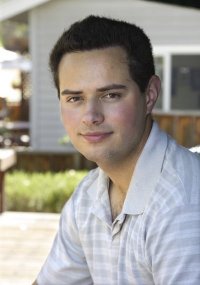Victor Quintanar-Zilinskas: Difference between revisions
From Santa Fe Institute Events Wiki
No edit summary |
No edit summary |
||
| Line 1: | Line 1: | ||
[[File:V Quintanar Z.jpg|Victor]] | [[File:V Quintanar Z.jpg|Victor]] | ||
'''Victor Quintanar-Zilinskas''' is a graduate student at the [http://en.wikipedia.org/wiki/University_of_California,_Irvine University of California, Irvine]. His | '''Victor Quintanar-Zilinskas''' is a graduate student at the [http://en.wikipedia.org/wiki/University_of_California,_Irvine University of California, Irvine]. He includes among his interests the systems biology of transcription factor gradient maintenance over long distances and the developmental effects of mechanical forces; these lines of work are pursued with [http://www.ucidevcell.org/faculty/edwin-monuki/ Ed Monuki]. His research focus, advised by [http://cbmspc.eng.uci.edu/ Zoran Nenadic] and linked with the interesting experimental results of his collaborators [http://jn.physiology.org/content/103/4/2301.abstract Xiangmin Xu], [http://frostiglab.bio.uci.edu/ Ron Frostig], and [http://cahill.bio.uci.edu/ Larry Cahill], is the emergence of system-level information processing properties of many-neuron (on the order of 1000s) networks. [http://en.wikipedia.org/wiki/Santa_Fe_Institute SFI] faculty member [http://lander-office.bio.uci.edu/landerfacts.html Arthur Lander] is, in one way or another, involved with all of Victor's projects. | ||
Victor intends for his research focus to, in the near future, | Victor intends for his research focus to, in the near future, evolve into the study of the following two phenomena. First, the working brain frequently witnesses the self-organization of brief episodes of synchronization between groups of neurons. Second, complex dynamics generate information (Turing patterns are an illustration of this idea); [http://www.ics.uci.edu/~welling/publications/papers/herding_icml09_final.pdf Modeling] and [http://www.jneurosci.org/content/30/27/9017.abstract EEG analysis] results suggest the possibility that probability inferences and information that is fundamentally an interpretation of (rather than intrinsic to) sensory input (e.g. odorant toxicity), respectively, are among the types of cognitively useful information that the brain's dynamics can produce. | ||
Victor was raised in [http://en.wikipedia.org/wiki/Palo_Alto,_California Palo Alto, CA] and his interests and outlooks are heavily influenced by his upbringing in [http://en.wikipedia.org/wiki/Silicon_Valley Silicon Valley's] technoculture. He double-majored in math and biology at [http://en.wikipedia.org/wiki/Santa_Clara_University Santa Clara University] (class of 2009), where he did his first computational neuroscience research, | Victor was raised in [http://en.wikipedia.org/wiki/Palo_Alto,_California Palo Alto, CA] and his interests and outlooks are heavily influenced by his upbringing in [http://en.wikipedia.org/wiki/Silicon_Valley Silicon Valley's] technoculture. He double-majored in math and biology at [http://en.wikipedia.org/wiki/Santa_Clara_University Santa Clara University] (class of 2009), where he did his first computational neuroscience research, sparking his current interests. He also worked with [http://www.sis.pitt.edu/~gbowker/ Geoffrey Bowker] (who was, at the time, at [http://en.wikipedia.org/wiki/Santa_Clara_University Santa Clara University]) to characterize the work practices of scholar communities that study complex systems (e.g. networks of ecologists that study various facets of the same ecosystem) and explain them in the context of the historical trajectory of scientific understanding of the systems under study. The study's conclusion, which will be appreciated by but unsurprising to this page's [http://en.wikipedia.org/wiki/Santa_Fe_Institute SFI]-affiliated readers, was that the increasing temporal resolution of data is encouraging a shift from the study of system processes to the study of salient events (e.g. shifts between stable states of the composition of an ocean bacteria population; large storms). Victor's current "applied philosophy" interest is the connections between [http://en.wikipedia.org/wiki/Constructivism Constructivism], creativity theory, and interdisciplinarity--and in these ideas informing educational practice (Victor is a huge fan of curricular individualization). | ||
Revision as of 01:48, 18 March 2011
Victor Quintanar-Zilinskas is a graduate student at the University of California, Irvine. He includes among his interests the systems biology of transcription factor gradient maintenance over long distances and the developmental effects of mechanical forces; these lines of work are pursued with Ed Monuki. His research focus, advised by Zoran Nenadic and linked with the interesting experimental results of his collaborators Xiangmin Xu, Ron Frostig, and Larry Cahill, is the emergence of system-level information processing properties of many-neuron (on the order of 1000s) networks. SFI faculty member Arthur Lander is, in one way or another, involved with all of Victor's projects.
Victor intends for his research focus to, in the near future, evolve into the study of the following two phenomena. First, the working brain frequently witnesses the self-organization of brief episodes of synchronization between groups of neurons. Second, complex dynamics generate information (Turing patterns are an illustration of this idea); Modeling and EEG analysis results suggest the possibility that probability inferences and information that is fundamentally an interpretation of (rather than intrinsic to) sensory input (e.g. odorant toxicity), respectively, are among the types of cognitively useful information that the brain's dynamics can produce.
Victor was raised in Palo Alto, CA and his interests and outlooks are heavily influenced by his upbringing in Silicon Valley's technoculture. He double-majored in math and biology at Santa Clara University (class of 2009), where he did his first computational neuroscience research, sparking his current interests. He also worked with Geoffrey Bowker (who was, at the time, at Santa Clara University) to characterize the work practices of scholar communities that study complex systems (e.g. networks of ecologists that study various facets of the same ecosystem) and explain them in the context of the historical trajectory of scientific understanding of the systems under study. The study's conclusion, which will be appreciated by but unsurprising to this page's SFI-affiliated readers, was that the increasing temporal resolution of data is encouraging a shift from the study of system processes to the study of salient events (e.g. shifts between stable states of the composition of an ocean bacteria population; large storms). Victor's current "applied philosophy" interest is the connections between Constructivism, creativity theory, and interdisciplinarity--and in these ideas informing educational practice (Victor is a huge fan of curricular individualization).

